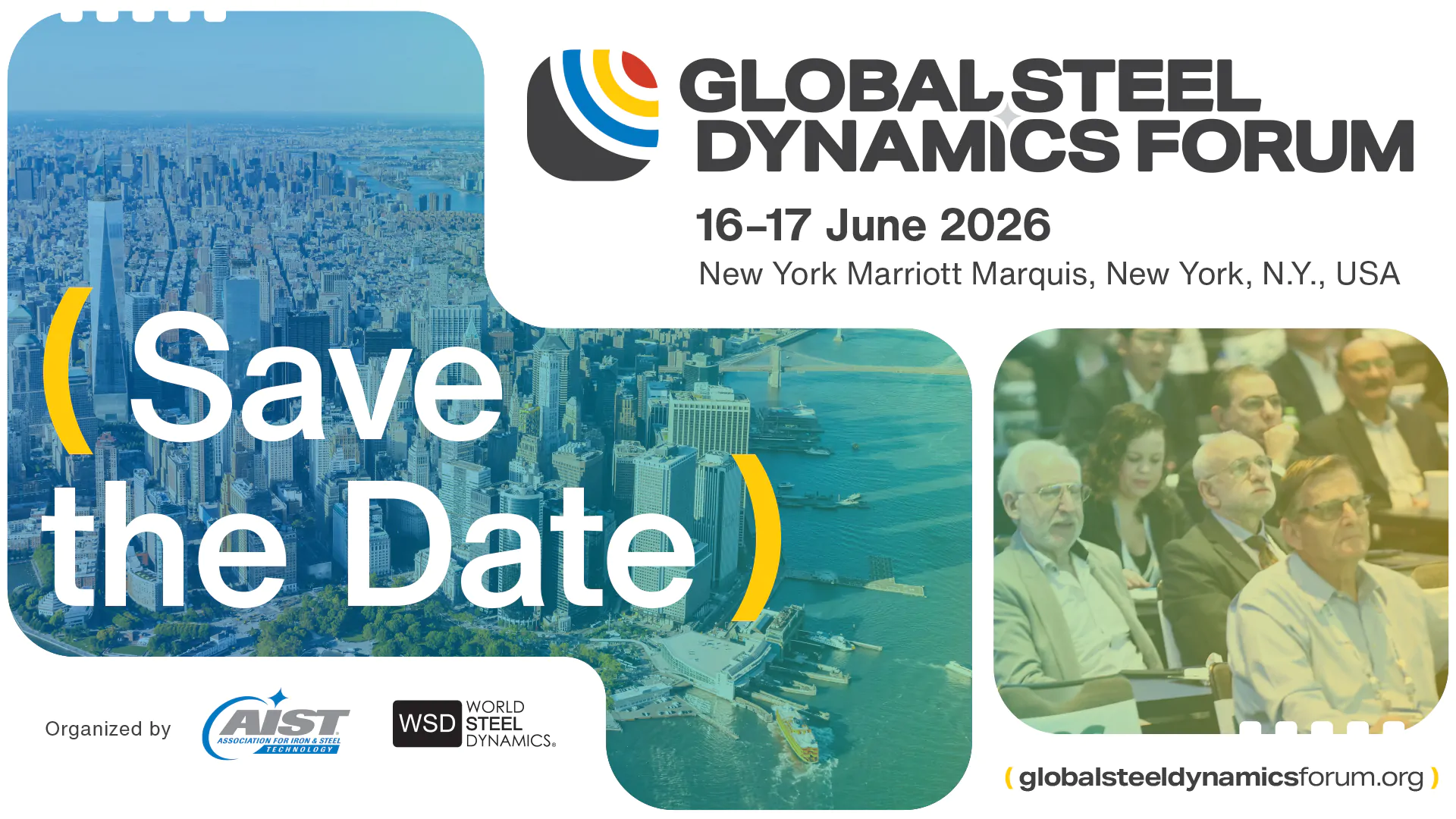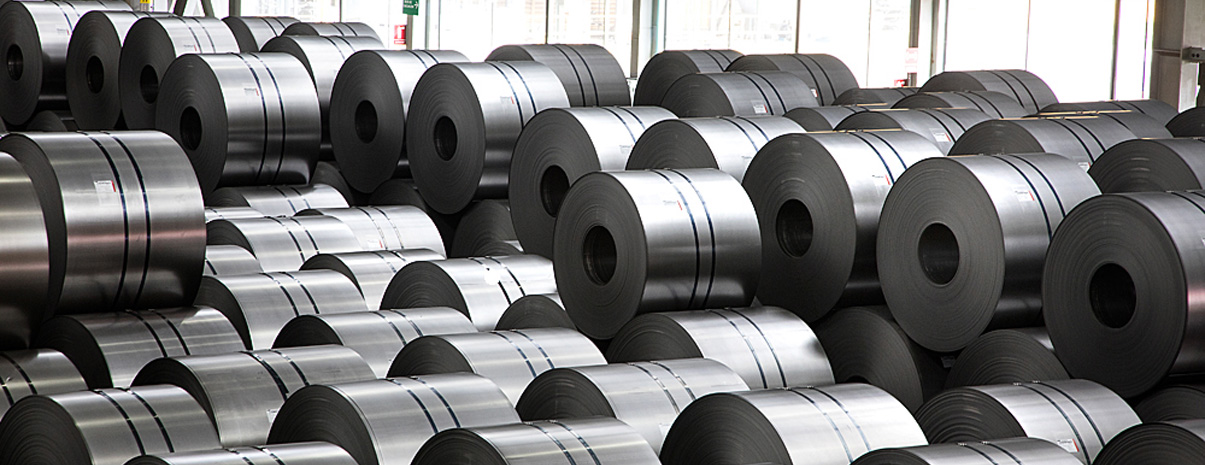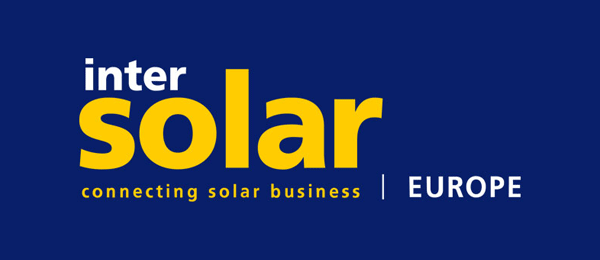
World Steel Dynamics 2026: The New Trends That Will Define the Steel Market
In this article, we will explore the trends that will define the steel market in the coming years, based on the insights to be offered at the Global Steel Dynamics Forum. Co-organized by World Steel Dynamics and the Association for Iron & Steel Technology, this third annual forum promises to deliver high-level strategic perspectives and exceptional networking opportunities. Attendees will certainly be able to hear directly from top decision-makers about how they are navigating current challenges, including new capital investment opportunities, green technologies, China's production peak, and changes in U.S. tariff programs.
The World Steel Dynamics Fair 2026 is positioning itself as the must-attend event for the most important executives in the global steel industry. On June 16-17, 2026, the New York Marriott Marquis will become the epicenter where steel leaders will gather to address the sector's most pressing challenges.
Below, we will analyze the current landscape of the steel market for 2026, the strategic investments that will shape the sector, advances in green technologies, the digitalization of the value chain, and changes in trade policies that will affect producers and consumers alike.
Current Landscape of the Steel Market in 2026
The global steel market is at a decisive moment. According to the latest analyses, 2026 will mark a turning point for the industry after several years of stagnation.
Global Production According to World Steel Association Forecast
The World Steel Association forecasts that global steel demand in 2025 will remain virtually stable compared to 2024, reaching approximately 1.749 billion metric tons. However, a modest recovery of 1.3% is expected for 2026, raising global demand to 1.773 billion tons. This positive, albeit cautious, outlook is supported by the demonstrated resilience of the world economy and the continued strength of public infrastructure investments.
The landscape reveals significant contrasts between regions. While the developed world will face a 0.5% decline in 2025, a 1.5% recovery is anticipated for 2026. On the other hand, emerging economies (excluding China) show more robust growth: 3.4% in 2025 and 4.7% in 2026. Notably, India stands out with an impressive projected growth of approximately 9% in both 2025 and 2026.
Impact of China and Its Production Peak
China, traditionally the steel giant, shows clear signs of having reached its production peak. Its domestic demand is expected to continue declining by approximately 2% in 2025, moderating to a 1% drop in 2026. This trend represents a slowdown of the decline observed since 2021, primarily driven by the prolonged crisis in the Chinese real estate sector.
Despite this domestic outlook, China's steel export sector has demonstrated notable resilience. The first seven months of 2025 recorded an 11.4% increase in exports, reaching record highs even in the face of growing international trade barriers. Baosteel, the country's largest listed producer, has announced ambitious plans to reach an export capacity of 15 million tons by 2026, reflecting a clear strategy to channel excess capacity to external markets.
Low-Cost Import Trends in the Americas
The impact of Chinese exports is particularly acute in Latin America. Over the past 15 years, Chinese exports of finished and semi-finished steel to the region grew by an astounding 233%. Currently, 39% of the steel consumed in Latin America is imported, reaching record levels.
This situation generates concerns in the regional industry, especially since global excess steel capacity is projected to reach approximately 630 million metric tons by 2026, exceeding the total production of all OECD countries. Meanwhile, the United States shows positive signs with expected growth of 1.8% in both 2025 and 2026, driven by continued infrastructure spending and pent-up demand in residential construction.
This phenomenon has been so significant that in some segments, such as flat steel, imports have quintupled since the pandemic, in a market where real consumption contracted by 30%, highlighting the profound imbalance facing the sector.
1. Strategic Investments in Infrastructure and Capacity
Investments in steel infrastructure are redefining the global steel production map. Faced with capacity and decarbonization challenges, companies are deploying expansion and modernization strategies on an international scale.
New Plants in Asia and the Middle East
Southeast Asia is emerging as a protagonist in global capacity expansion. According to SEAISI research, by 2026, steel production capacity in this region will reach 90.8 million tons per year, a notable increase from the 71.8 million recorded in 2020. This growth comes mainly from Indonesia, Malaysia, and Vietnam, driven by Chinese investments. Effectively, this region will become a primary exporter of steel products, surpassing its domestic demand.
On the other hand, the Middle East is consolidating its strategic position. In 2021, the region added approximately 8.27 million tons of capacity, mainly in Iran, Iraq, and Syria. Furthermore, major Chinese groups are expanding their presence in the region. Baosteel, for example, signed a joint venture in 2023 with Saudi Aramco to build an integrated steel plate manufacturing complex in Saudi Arabia, with an investment close to $2 billion and a capacity to produce up to 1.5 million tons annually.

Modernization of Facilities in the U.S. and Europe
In Europe, investments are focused on modernization and decarbonization. The sector faces the challenge of undertaking significant investments to modernize its facilities while maintaining competitiveness. Steel Dynamics, for its part, is implementing an investment cycle of $4.77 billion, including the Sinton sheet plant, positioning itself as a solid alternative for investors seeking international exposure.
In Spain, the steel sector represents 4.6% of industrial GDP, employs nearly 60,000 workers, and has an annual revenue of €14 billion. With 22 manufacturing plants and 50 rolling installations, the country is driving the sector's transformation through the Industrial Decarbonization PERTE, which will mobilize up to €11.8 billion in total investment. Likewise, the Government has doubled aid for compensation of costs for indirect CO₂ emissions, reaching €600 million.
World Steel Dynamics Inc's Role in Investment Analysis
World Steel Dynamics Inc has become a benchmark for the strategic analysis of steel investments. Its reports help identify opportunities in emerging regions, anticipating that the world will add around 200 million tons of capacity between 2024-2026.
During the World Steel Dynamics Fair 2026, detailed analyses of global investment trends will be presented, with particular attention to Asian expansion and Western modernization. Executives use these studies to evaluate high-impact projects, such as the new hydrogen-based direct reduction facilities that are revolutionizing sustainable production.
2. Advances in Green Technologies and Decarbonization
Decarbonization is emerging as the greatest challenge for the global steel industry. With an industry responsible for approximately 8% of global CO₂ emissions, the World Steel Dynamics Fair 2026 will place special emphasis on the technologies that are transforming traditional production processes.
Use of Hydrogen in Steel Production
Green hydrogen is positioning itself as the undisputed protagonist in the new steel era. This technology allows for the replacement of coal in the direct reduction of iron ore, generating only water vapor as a byproduct. The HYBRIT project, led by SSAB, LKAB and Vattenfall, set a milestone in 2021 by producing the world's first fossil-free steel, and plans to reach commercial production by 2026.
However, the transition faces significant obstacles. According to industry experts, the "headwinds" include "the lack of green hydrogen, high energy consumption, the slow scaling of technology, and the bottleneck in project construction." Despite these challenges, IDTechEx projects that hydrogen-based green steel production will reach 46 million tons by 2035.
Carbon Capture in Electric Arc Furnaces
On the other hand, carbon capture, utilization, and storage (CCUS) is emerging as a transitional solution for the European industry. To achieve emission reductions greater than 80%, three options currently stand out: hydrogen, natural gas with CCUS in direct reduced iron manufacturing, or the intensive use of scrap.
Major European producers are evaluating this technology, although "the complexity of the capture process for this industry is one of the great challenges, as the most common production process has several sources of CO₂." Currently, the steel and cement industries represent just 5% of large-scale CCUS projects.
Environmental Certifications and Regulatory Pressure
In this area, ResponsibleSteel™ has launched the first international CSR certification for the steel industry, covering 12 fundamental principles ranging from climate change to water management. This certification is becoming a competitive differentiator in demanding markets.
Furthermore, the Carbon Border Adjustment Mechanism (CBAM) implemented by the European Union is reconfiguring global trade. According to Alacero, this mechanism could "distort steel trade globally," while Chinese producers are already aligning themselves to comply with these new regulations. Certainly, these regulatory pressures are accelerating commitments such as that of the European industry to reduce emissions by 30% by 2030 compared to 2021.
3. Digitalization and Automation in the Value Chain
The digital revolution is fundamentally reshaping the production and logistical processes of the steel industry. During the World Steel Dynamics Fair 2026, advances in digitalization will occupy a central place in discussions on competitiveness and efficiency.
Application of Artificial Intelligence in Smelting Processes
A pioneering development by the AZTERLAN Metallurgy Research Center combines real-time monitoring with predictive models to propose the optimal recipe for raw materials based on the available scrap yard. This intelligent system, based on the Sentinel® Platform, interconnects information on material availability, chemical verification certificates, and data from the control plan through a digital twin of the process.
The algorithm monitors both metallurgical quality and the concentration of unwanted elements in the melt, calculating an optimal mix of raw materials at the lowest possible cost. Additionally, the use of AI allows for identifying and correcting incidents, reducing production costs, and improving the quality of the final product.
Digital Traceability Systems in Steel Logistics
The growing complexity of supply chains forces companies to precisely control the flow of raw materials and products. The European Union's Digital Product Passport (DPP) drives this transformation, turning traceability into a predictive and strategic instrument.
The benefits are tangible:
- Reduction in operational costs
- Decrease in environmental impact
- Strengthening of cybersecurity
- Improvement in international competitiveness
However, adaptation is more complex for SMEs, which have fewer resources to implement advanced technologies.
Cases Presented at the World Steel Dynamics Conference
The panel "New technologies, digitalization and automation for efficiency and sustainability challenges" at the 2025 Alacero Summit presented significant experiences with speakers from Primetals, Russula, and Accenture. On the other hand, the session "AI and innovation in the industry" showed practical applications in the sector.
Indeed, leading companies are integrating solutions such as predictive analytics to anticipate failures, robotics for repetitive processes, IoT sensors that monitor operational conditions in real time, and intelligent management systems. This digital transformation also opens the door to more sustainable practices, with better energy use and less material waste.
4. Changes in Trade Policy and Tariffs
The steel trade landscape has undergone radical transformations in 2025-2026, with new protectionist policies redefining the global flow of the metal.

New Bilateral Agreements and Their Impact
Trade negotiations have taken on a leading role in the international steel market. The U.S. and Canada are preparing a historic agreement focused on steel, aluminum, and energy that will be signed during the upcoming APEC summit in South Korea. This pact seeks to end years of economic tensions between the two North American powers. Meanwhile, the EU is trying to negotiate with Washington to reduce the 50% U.S. tariff on European steel.
Tariff Review in the U.S. and EU
The European Union has announced forceful measures to protect its steel sector. In October 2025, Brussels proposed doubling tariffs on steel imports from 25% to 50%. Furthermore, it will reduce the quota for tariff-free imported steel by 47%, setting a new annual limit of 18.3 million tons. This policy aims to counter Chinese competition and align with the U.S. trade strategy.
The expected effects include:
- Pressure for EU-U.S. negotiations on a joint strategy regarding China
- Introduction of a new system for tracing the origin of steel
- Significant impact on exporters like Turkey, India, South Korea, and Vietnam
Adaptation Strategies of Latin American Exporters
Faced with this restrictive scenario, Latin American exporters are exploring alternatives. Brazil, whose iron and steel exports to the EU represent approximately 12% of the total, faces challenges due to the carbon intensity of its production (0.37 kgCO₂e/$). On the other hand, Chile, with low carbon intensity (0.13 kgCO₂e/$), could leverage this competitive advantage.
The EU's Carbon Border Adjustment Mechanism (CBAM) adds another dimension to these trade dynamics. Venezuela, which exports 50% of its iron and steel to the EU, is particularly vulnerable due to its high emission intensity. According to World Steel Dynamics, this global tariff reconfiguration will define the sector's trade flows for the next decade.
5. Global Demand and Consumption Outlook
Steel consumption patterns are undergoing significant changes that will define the market in the coming years. After a stagnant 2025, World Steel Association projects global growth of 1.3% for 2026, raising world demand to 1.773 billion tons.
Growth in the Automotive and Construction Sectors
The construction sector maintains its dominant position, representing 64% of global hot-rolled steel demand. In 2024, the automotive industry consumed approximately 19.8 million metric tons of this material, with 8.4% growth driven primarily by the expansion of the North American electric vehicle market. Furthermore, the European Union has allocated funds for over 4,000 infrastructure developments that incorporate hot-rolled steel components.
Demand for Recycled Steel vs. Primary Steel
The transition towards a green economy is reconfiguring demand by type of steel. In 2024, over 36% of global factories incorporated electric arc furnaces, technology that facilitates the use of scrap. Steel derived from recycled materials through this process has increased its adoption especially in the United States and Europe, contributing to 43% of the supply.
2026-2030 Projections According to World Steel Dynamics
While developed countries will face a 0.5% decline in 2025 before recovering in 2026, developing economies (excluding China) will show robust growth of 3.4% and 4.7% respectively. India stands out with a projected increase of 9% during these two years. According to World Steel Dynamics, the renewable energy sector will represent a significant growth vector, having already consumed 6.1 million metric tons in 2024.
Conclusion
The World Steel Dynamics Fair 2026 will certainly mark a turning point for the global steel industry. Throughout this analysis, we have seen how the steel market is undergoing an unprecedented transformation driven by multiple interconnected factors. Despite recent stagnation, projections for 2026 show promising signs with a modest 1.3% growth in global demand.
Undoubtedly, the new geographical configuration of production reflects deep structural changes. China, after dominating the landscape for decades, shows clear signs of having reached its production peak, while regions like India and Southeast Asia are emerging strongly. At the same time, strategic investments in plant modernization, especially in Europe and the United States, seek to balance competitiveness and sustainability.
Decarbonization, without a doubt, represents the sector's greatest challenge and opportunity. Green hydrogen technologies and carbon capture are redefining traditional production processes. Although they face significant obstacles, these innovations will shape the future of an industry seeking to reduce its environmental footprint while maintaining its economic relevance.
In parallel, digitalization is radically transforming the steel value chain. Artificial intelligence applied to smelting processes, advanced traceability systems, and automation not only improve operational efficiency but also enable progress towards more sustainable practices.
The trade landscape, on the other hand, is being reconfigured through new protectionist policies and bilateral agreements. These dynamics will define the global flows of the metal for the next decade, forcing producers and exporters to adapt quickly to an increasingly complex environment.
Finally, consumption patterns are evolving with sustained growth in sectors such as construction, automotive, and renewable energy. The transition towards a green economy is driving demand for recycled steel, while emerging economies, especially India, are leading global growth.
This analysis demonstrates that the steel sector is at a historic crossroads. The strategic decisions made by industry leaders today, in investments, technological innovation, and adaptation to new commercial realities, will determine their viability and success in the coming decades. The World Steel Dynamics Fair 2026 will undoubtedly offer valuable perspectives for navigating this complex but promising future of global steel.










